FIELD VETERINARY REPORT FOR SOUTHERN CONSERVATION AREA MOBILE VETERINARY UNIT FOR THE MONTH OF JUNE 2017 Reported by Ndambiri Ephantus Introduction Amboseli ecosystem is quickly drying up having received relatively low rainfall during the April-May period
FIELD VETERINARY REPORT FOR SOUTHERN CONSERVATION AREA MOBILE VETERINARY UNIT FOR THE MONTH OF JUNE 2017
Reported by Ndambiri Ephantus
Introduction
Amboseli ecosystem is quickly drying up having received relatively low rainfall during the April-May period. Strong winds are prevalent which compromises visibility due to raising dust. Towards the month end the day’s sunshine has been replaced with clouds and cold as winter sets in.
The Unit also received two students from Indiana US Purdue University Vet School who were on an international attachment program through the KWS Training Office.
The following are veterinary activities attended to during the month;
CASE#1 ELEPHANT TREATMENT
Date: 2nd June 2017
Species: Elephant
Sex: Female
Age: Adult
Location: Oltukai, Amboseli National Park
History
The injured matriarch of 53 years was spotted with a spear wound oozing pus to the right rump by the Amboseli Elephant Research Trust who immediately informed the Vet Unit. The Vet Unit responded immediately to offer treatment
Immobilization, examination and treatment
The elephant was at the edge of the swamp with nine other elephants. One vehicle was strategically placed to block the herd from entering the swamp. After confirmation of the injury a dart was prepared comprising of 10mgs Etorphine and 1500 I.U Hyaluronidase to shorten the knock down time considering the marshy terrain nearby. The dart was placed in the left gluteal area and the matriarch was fully immobilized in seven minutes assuming left lateral recumbence. The family members were startled to see the matriarch down and ran to her side. They were forced away by the use of the two vehicles then one vehicle kept the members at bay while the vet vehicle attended the injured female. She was blindfolded using the right ear and the trunk was kept patent by use of a piece of stick. She was constantly dowsed with water to prevent hyperthermia.
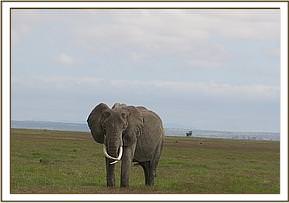

Her body condition was still good but the injury was exuding gray pus. The injury was probed using long forceps to establish the depth and also to detect any foreign body. There was no foreign body and it was about 15cm deep.
The pus filled pouch was infiltrated with Hydrogen peroxide and Tincture of Iodine, then drained manually three times. This ensured thorough cleaning of organic debris from the pouch. It was then infused with 10 grams of Cloxacillin antibiotic cream after which wet green clay was packed into the wound. Superficially it was sprayed with Tetracycline wound spray to repel flies from feeding from the site. Finally, 50ml Catosal as a metabolic stimulant, 30000mgs Tetracycline broad spectrum antibiotic and 100mgs Dexamethasone anti-inflammatory were administered at different intramuscular sites.
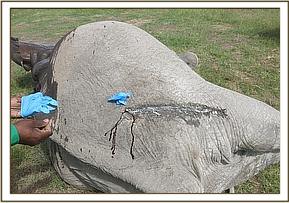

Reversal and Prognosis
The anesthetic was reversed by administration of 20mgs Naltrexone mixed with 24mgs Diprenorphine into the superficial ear vein. Complete reversal was attained after two minutes and she ambulated away to join the family members who were about 50m away.
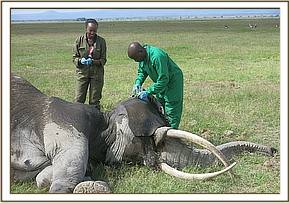

The prognosis for this elephant is good because the injury was spotted early followed by timely intervention. Monitoring will continue and review will be done if need be in two weeks time.
CASE#2 Internship Exercise
Date: 13/06/2017
Species: Baboon
Sex: Male
Age: Adult
Location: Amboseli National Park
History
After more than three months of exposure to wildlife medicine an exercise was organized for the intern to show her skills so far attained concerning darting, anesthesia, risks plus emergencies encountered and surgery. The Intern was tasked to dart a male baboon and carry out a vasectomy. She briefed the vet team on the day of exercise and tasked the team members as she set out for the exercise.
Immobilization
A dart for a male baboon of approximately 30kg was prepared prior to the search for the candidate. This constituted of 750mgs Ketamine in 3cl topped up with water. The troop was located near the park headquarters’ airstrip. The intern darted the baboon from the vehicle and directed the driver on how to approach. It was fully immobilized in five minutes and taken under an acacia shade on a stretcher where the procedure could be carried out safely.
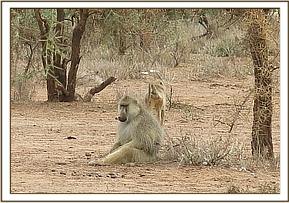

A thorough and quick examination confirmed this was a healthy candidate for the procedure.
Procedure
The candidate was placed on right recumbence and the tongue was pulled out of the mouth cavity to allow drainage of any exudate from the mouth. It was blindfolded using a towel and the operation site was exposed by holding the hind limbs apart by one of the assistants. The surgeon (Intern) cleaned the operation site and conducted the vasectomy. Anesthesia was monitored throughout the exercise by recording breathing rate and depth, temperature, heart rate and hand/limb reflexes.
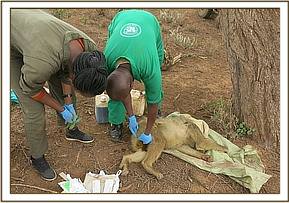

Halfway through the operation the candidate exhibited pain reflex by trying to take the left forelimb to the inguinal area. This necessitated an additional 200mgs Ketamine into the neck muscles after forty minutes post darting and the procedure continued smoothly. A subcuticular stitch of chromic cut gut was used to suture the skin closed.
Post-operative Treatment/Sampling
Both suture lines were infiltrated with 5gms Cloxacillin antibiotic and sprayed with Tetracycline wound spray liberally. Systemically the candidate was covered with 450mgs Ampicillin mixed with 5mgs Dexamethasone administered intramuscularly. The eyes were infiltrated with Cloxacillin eye ointment to prevent damage.
Whole blood and tissue samples were collected for further study. No ectoparasites were found for examination but a fecal sample was collected from the rectum and placed in a fecal bottle for egg count and parasitology. An ear notch on the left ear was made for post release monitoring. The notch was sprayed with Tetracycline wound spray topically while bleeding was controlled by preplacing the clamps before cutting the ear tissue.
Reversal
The baboon was checked for any immediate post-operative complications such as bleeding and scrotal swelling then left in a shaded area and monitored as the anesthetic wore off. The animal recovered from anesthesia in two and half hours by exhibiting the lighting up reflex. It recovered smoothly and in 30 minutes was fully awake and aware of its surroundings. It was able to climb up acacias by the time it was left on its own. Monitoring will continue for any noticeable complication after surgery and intervention will be done accordingly
CASE#3 CASE REVIEW
Date: 14th June 2016
Species: Elephant
Sex: Female
Age: Adult
Location: Amboseli National Park
History
This female elephant was treated on the 28/5/2017 for a spear injury. It had emaciated substantially before treatment and had been given a guarded prognosis which was subject to review upon case review.
Review Examination
The animal was seen on 13/6/2017 by KWS rangers on patrol and then by a KWS research officer on 14/6/2017 who quickly reached for the Vet attention. The Vet Unit attended to the location with the Amboseli Elephant Research Trust to carry out a review. It was observed that the animal had a full tummy and was ambulating well. It was noticeable that the muscle cover had improved since the last treatment two weeks previous. She was urged to ambulate and there was very little discharge from the injury site. It was decided to review her again after ten days and if there is any discharge from the wound she will be immobilized to further drain the wound.
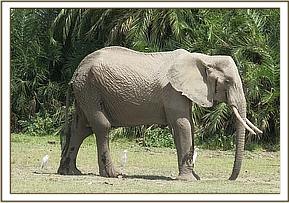
Prognosis
This was revised from guarded to fair. It is subject to another revision after carrying out the next review.
CASE#4 INTERNSHIP EXERCISE
Date: 14/06/2017
Species: Impala
Sex: Male
Age: Adult
Location: Amboseli National Park
History
Following the successful demonstration of a baboon vasectomy, the intern was tasked to carry out the same procedure on a different species; an impala. The intern was tasked to lecture the supervisor on the procedure concerning predarting considerations, darting equipment and drug choices available, drugs of choice, species narcosis process and risk considerations, surgery procedure, post-surgery treatment/sampling. A go ahead was given by the supervisor and she assembled the vet team, briefed them accordingly and then set out for the exercise.
Immobilization
Narcosis was to be achieved by using 2mgs Etorphine and 30mgs Azaperone. To counter respiration risk, 10mgs Butorphanol was pre-drawn using a 2cc syringe. A candidate was identified and successfully darted. It took eight minutes to be fully immobilized after wobbling up and down for last 2 minutes of sedation. An examination was carried out prior to surgery and after the animal was found to be in good health, the operation commenced.
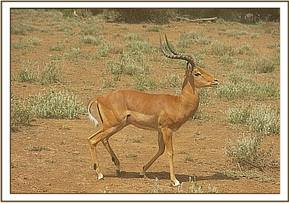

Procedure
The candidate was placed on right lateral recumbence so that occurrence of bloating could be noted and acted upon accordingly. The intern then began the procedure, beginning with cleaning of the scrotum. Anesthesia was monitored throughout the exercise by recording breathing rate and depth, Temperature, heart rate and any pain reflex.
The procedure took 50 minutes post darting and no adverse effect of narcosis was noted.
Post-operative Treatment/Sampling
Superficially the incision lines were sprayed with Tetracycline wound spray generously. The candidate was covered with 2100mgs Tetracycline and 10mgs Dexamethasone administered intramuscularly at different sites. The eyes were infiltrated with Cloxacillin eye ointment to prevent corneal damage.
Whole blood was sampled from the jugular vein and a tissue sample collected for genetic study. An ear notch on the left ear was made for post release monitoring. The notch was sprayed with Tetracycline wound spray topically while bleeding was controlled by preplacing the clamps before cutting. Ticks were collected from different locations on the animal and placed in tick bottles with preservative. A fecal sample was collected from the rectum and placed in a fecal bottle for egg count and parasitology.
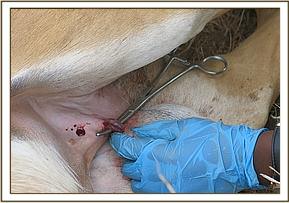

Reversal
The anesthetic was reversed using 6mgs Diprenorphine into the jugular vein. The animal assumed sternal recumbence after one minute and was up in all four shortly after. Monitoring will continue for any noticeable complication after surgery and intervention will be done when needed.
CASE#5 ELEPHANT TREATMENT
Date: 17/06/2017
Species: Elephant
Sex: Male
Age: Adult
Location: Kilaguni, Tsavo West National Park
History
This male elephant had a severe trunk injury and was reported at the Kilaguni waterhole by the Lodge security personnel. The Vet Unit travelled from Amboseli National Park to Tsavo West National Park Kilaguni Lodge and met the lodge manager regarding the injured male elephant. It had been spotted last evening retreating into the nearby bush together with four other males. After an hours search the elephant was discovered 2kms away in the company of several males, females and calves.
Immobilization and examination
The vet darted the elephant from a vehicle with 15mgs Etorphine and 500 I.U. Hyalase. The candidate was sandwiched in a herd of seven making darting tricky, but when an opportunity presented itself the vet was successfully able to dart the elephant which sent the whole herd into fright. The darted individual was difficult to track as members of the herd scattered throughout dense bush. After following several trails the candidate was found deep in narcosis on left lateral recumbence 18 minutes posts darting.
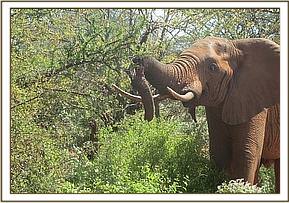

A quick examination was conducted on the seemingly injured trunk. It was established that the injury had healed completely and what was appearing pinkish was the inner mucosa of the exposed trunk. The 2/5 distal portion of the trunk was loosely attached to the upper portion, though this was still functional. There was no need to amputate and suturing trunks has been proven to be ineffective due to muscular contractions and elasticity. The animal had to be revived quickly in order to avoid any complications of narcosis.
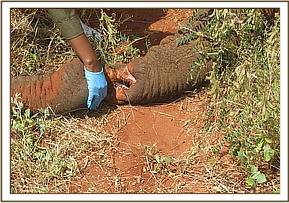

The severing of the trunk was most likely caused by a snare and the wound had healed with contracture resulting in abnormal anatomy of the trunk. The animal was covered with 100mgs Dexamethasone and the right eye and dart wound were infiltrated with Cloxacillin antibiotic cream to avoid corneal drying and abscess formation.
Reversal and Prognosis
The anesthetic was reversed using 30mgs Diprenorphine mixed with 20mgs Naltrexone into the ear vein. It was on all fours after four minutes and ambulated away slowly and calmly. Prognosis is good.
CASE#6 ELEPHANT TREATMENT
Date: 24th June 2017
Species: Elephant
Sex: Male
Age: Adult
Location: Manyani, Tsavo East National Park
History
This elephant was reported to the Amboseli Mobile vet Unit by the DSWT Kaluku HQ after being spotted at the Manyani Gate waterhole exhibiting lameness of the left forelimb by a KWS customer care officer. The Amboseli Mobile Vet Unit set out for Manyani and after four hours drive the elephant was found browsing in company of another male.
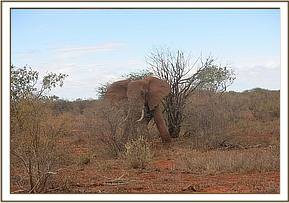

Immobilization, examination and treatment
The lame elephant was immobilized using 13mgs Etorphine and 500 I.U. Hyaluronidase from a vehicle. The right ear was used to cover the right eye to shield it from direct sunlight. A piece of dry stick was used to keep the trunk patent across the end of distal open nares. Examination on the medial side of the front left limb yielded no injury. The bull was turned onto the right lateral recumbence using straps pulled by the vehicle to allow examination of the lateral side of the fore left limb. The left forelimb appeared swollen from the carpal joint downwards. The swollen limb was palpated for crepitation or lumps and none were noted. An 18 gauge needle was inserted at two different locations on the anterior and posterior side of the limb to aspirate and there was no exudate. This seemed to be soft tissue injury possibly caused by a sprain of the limb.
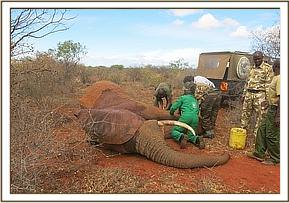

The animal was covered with 100mgs Dexamethasone intravenous and 15000mgs Amoxicillin intramuscular. Cloxacillin antibiotic cream was infiltrated into the left eye and into the dart site to avoid injury and abscessiation respectively.
Reversal and Prognosis
The anesthetic was reversed using 80mgs of Naltrexone injected into the superficial ear vein and the animal was completely up in three minutes. It limped away in fear into the thickets. Prognosis is good.
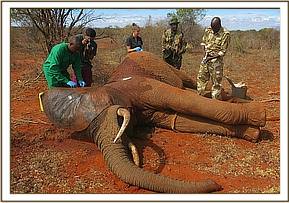

CASE#7 ZEBRA TREATMENT
Date: 25/06/2017
Species: Zebra
Sex: Male
Age: Sub-adult
Location; Amboseli National Park
History
This male zebra was spotted by the Amboseli Mobile Vet Unit on the late evening of 29/06/2017 during normal patrols within the park. The zebra was seen limping severely on the right hind limb as a result of a huge swelling at the lateral side of the thigh. As it was already late in the day, intervention was planned for the following morning. The next day the zebra was found lying down and further enlargement of the swelling was noted. It was suspected to be an abscess due to internal bleeding caused by blunt object trauma on thigh lateral surface.
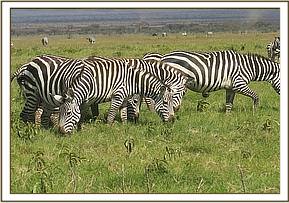

Immobilization, examination and treatment
It was immobilized using 2mgs Etorphine and 35mgs Azaperone in 1.5cc dart topped up with water for injection. A vehicle was used to approach the animal which was among other zebras grazing on the expansive Park savannah. The other zebras were not startled by the vehicle approach or post darting. As the zebra begun to exhibit sedation signs, it separated itself from the group and assumed right recumbence after five minutes.
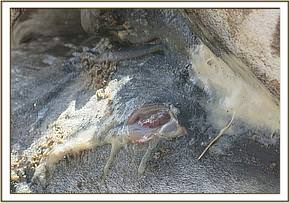

The discharging wound was possibly due to an unsuccessful hyena attack. The injury was more than two weeks old and had no maggot infestation. Due to shearing of the muscles the dead space was about fifteen centimeters deep though there was no muscle tear
Systemically it was injected with 9000mgs Tetracycline and 10ml B-Complex into different muscle sites. 15grams of Cloxacillin antibiotic cream was infiltrated into the dead space of the wound, eyes and into the dart site to cater for any sepsis.
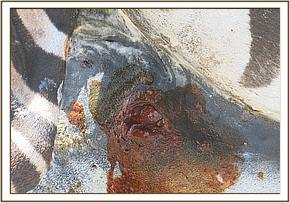

Reversal and Prognosis
Revival from narcosis was achieved using 20mgs of Naltrexone which was injected into the jugular vein. The zebra was up in one minute because it had already begun to be come around prior to the revival drug and it called for the rest of group members. Prognosis is good.
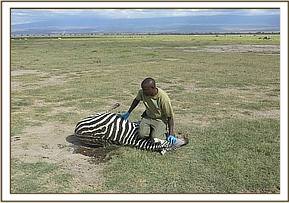

CASE # 8; Abscessed Wildebeest Calf
Date: 30/06/2017
Species: Wildebeest
Sex: Male
Age: Juvenile
Location; Amboseli National Park
History
This sub adult wildebeest was noted to have a discharging wound at the right medial perineal area causing alopecia on the medial side of the right limb distally. There was no resultant lameness but the wound was a nuisance as the animal was listless due to flies’ irritation. The zebra was spotted on routine patrol by the Vet Unit and was a perfect demonstration of immobilization and intervention procedure to the interns visiting from Purdue University Students based in Indiana, US.
Immobilization, examination and treatment
Immobilization was achieved by use of 2mgs Etorphine and 10mgs Xylazine in a 1.5cc dart topped up with water for injection. It was difficult approaching the herd of about 20 wildebeest using vehicle as it was weary and avoided the vehicle. The first dart did not discharge completely and after ten minutes a second dart was used and the calf assumed left lateral recumbence in four minutes. The rest of the herd members kept close but moved away when the vehicle approached.


The swelling was palpated and the softest area located. It was hot to the touch and appeared to be under pressure due to a buildup of fluid inside. An 18 gauge needle was inserted and straw coloured transudate was expressed. The calf was noted to be very anemic depicted by pale mucus membranes and delayed capillary refill time.


A surgical blade was used to puncture the abscess at the softest location and extended about three centimeters downwards to allow self-drainage. The transudate was gently expressed manually and the pouch cleaned using 200ml Hydrogen Peroxide followed by tincture of Iodine. Four gauze pieces were packed into the dead space after 4500mgs Amoxicillin was infiltrated into the wound. Systemically it was injected with 450mgs Amoxicillin, 5ml B-Complex into different muscle sites and 10mgs of Dexamethasone as an anti-inflammatory, followed by 100ml of 5% Glucose subcutaneously to supply energy and also to counter the anticipated fluid imbalance due to expressed transudate which was about ¾ litre.
The operation lasted for an hour and a half but half way through the patient developed shallow respiration which necessitated the administration of 60mgs Doxapram to improve respiration. This stimulation was enough to allow the operation to go on smoothly thereafter.
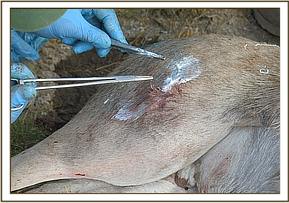

Reversal and Prognosis
The anesthetic was reversed by administration of 18.75mgs Yohimbine into the jugular vein followed by 8mgs Naltrexone shortly after. The wildebeest was on sternal recumbence after two minutes post reversal administration. It was released facing the direction of where the herd was resting. It oriented itself and saw the herd and started bleating. The dam and herd and came running to meet the calf. Prognosis is guarded because of the vulnerability to the predators.


Acknowledgement
The Unit profoundly takes this opportunity to express gratitude to the generous sponsorship of its activities by DSWT together with KWS. These undertakings are successful because of the amicable cooperation of all conservation players within the entire Amboseli ecosystem and its’ surroundings including the Community Conservancies, people of good will and NGOs such as the Big Life Foundation among others. For all these we feel honored and we hope same efforts will be forthcoming









































